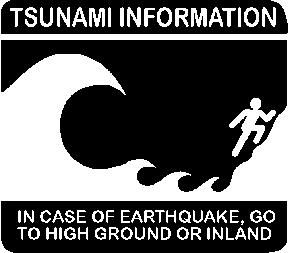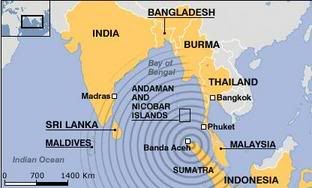Asia Tsunami Disaster

The sign is pretty obvious isnt it? Well, Boxing Day and look what has happened..This Asian Tsunami Disaster swept through several coastlines as well as lifes..Just yesterday one might just be enjoying with the entire family on the dining table for a good XMas Dinner and the day after, half the people that was on the table might have well been swept away from this disaster. Just a couple of weeks ago, 110 long-finned pilot whales and 10 bottle-nosed dolphins have been found dead after beaching themselves on Australia's island state of Tasmania. The Marine Biologist experts was not certain what causes whales and other ocean mammals to beach themselves and perhaps, just perhaps from my opinion that this could have very well been the first sign of this whole disaster..Sharks are guided by heat and Pilot Whales are guided by Deep Water Currents aka Thermohaline Circulation (I did some research). Oh Well..It might be or it might not be..
Anyway, on the day of this disaster my day was fine, i actually was in Great Ocean Road where its right next to Indian Ocean. Freaky eh? Oh Well shite happens..Anyway, gathered some information from various sites..And here's what i gather with so far..
Tsunami comes from the Japanese tsu (harbor) and nami (wave). Tsunamis are often incorrectly called tidal waves, but tides have nothing to do with them (though the damage may be worse if a tsunami hits at high tide).
A tsunami (pronounced tsoo-nah-mee) is a wave train, or series of waves, generated in a body of water by an impulsive disturbance that vertically displaces the water column. Earthquakes, landslides, volcanic eruptions, explosions, and even the impact of cosmic bodies, such as meteorites, can generate tsunamis. Tsunamis can savagely attack coastlines, causing devastating property damage and loss of life.
Tsunamis are unlike wind-generated waves, which many of us may have observed on a local lake or at a coastal beach, in that they are characterised as shallow-water waves, with long periods and wave lengths.
Recent tsunamis
1946: An earthquake in the Aleutian islands sent a tsunami to Hawaii, killing 159 people (only five died in Alaska).
1964: An Alaskan earthquake triggered a tsunami up to 20 feet tall that killed 11 people as far away as Crescent City, California and caused more than 120 deaths in all. More on the Web.
1983: 104 people in western Japan were killed by a tsunami spawned from a nearby earthquake.
1998: A Papua New Guinea tsunami killed roughly 3,000 people. A 7.1 magnitude earthquake 15 miles offshore was followed within 10 minutes by a wave some 40 feet tall. The villages of Arop and Warapu were destroyed.
Asia Tsunami

Asia Earthquake Explained

Indonesia is prone to seismic upheaval because of its proximity to the "Ring of Fire", an area around the Pacific Ocean basin where tectonic plates intersect and volcanoes erupt.

The quake occurred close to the island of Sumatra. Two tectonic plates, the Australian and Eurasian plates, meet just off Sumatra's south-west coast, grinding together and sending periodic seismic tremors through the region. At 0759 (0059 GMT) a violent rupture occurred on the sea floor along a fault about 1,000km long.

All along the rupture the seafloor was shunted vertically by about 10 metres. This movement displaced hundreds of cubic kilometres of the overlaying water, generating a massive tsunami, or sea surge. The wave then fanned out across the Indian Ocean at enormous speed.

The 9 magnitude quake, which was the strongest in the world for at least 40 years, wreaked havoc across the whole region. Walls of water, tens of metres high, slammed into coastal resorts thousands of miles apart. Surging seas and floods were reported as far away as east Africa.

Prayers to victims of this disaster
 M y - s t o r y - o f - a n - e v e r t o n i a n .
M y - s t o r y - o f - a n - e v e r t o n i a n . 


